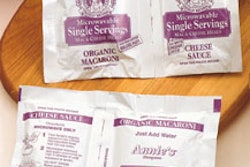
After three years of experience with mandated Hazard Analysis Critical Control Points programs, both consumer and industry groups are beginning to grumble loudly, and for different reasons. Consumer groups think the Food & Drug Administration is asleep at the rudder. On the other hand, meat groups have a beef with the U.S. Dept. of Agriculture’s use of microbiological standards for salmonella. Against that backdrop of discontent, both agencies say they may be tightening their HACCP standards this year. Having recently taken its first enforcement action against a seafood processor for HACCP insufficiencies, the FDA shows signs of responding to political pressure. At hearings in the Senate Agriculture Committee last September, Caroline Smith-DeWaal, director of food safety for the Center for Science in the Public Interest, reeled off FDA’s own statistics that showed, for example, that only 24% of seafood plants had implemented a HACCP plan that had gained FDA approval by 1999. She also cited FDA numbers that showed more than 60% of smoked, vacuum-packed and cooked, ready-to-eat fish product marketers lacked adequate pathogen controls in their HACCP plans. “Seafood HACCP is a failure,” says DeWaal. In response to complaints like that, Sens. Richard Lugar (R-IN) and Tom Harkin (D-IA), the chairman and ranking Democrat on the Senate Agriculture Committee, asked the General Accounting Office to do a study of FDA administration of the seafood HACCP program. Their request alluded to “a seemingly low compliance rate among seafood processors.” Larry Dyckman, the GAO supervisor for the upcoming report, says it should land on Congress’s desk at about the time representatives are returning to Washington in late January.
Political heat The FDA is trying to get out in front of any potential political pressure. The agency recently filed its first seafood HACCP enforcement action, which resulted in the signing of a consent decree by a company the FDA refuses to name. The seafood HACCP program is so sensitive that neither Phil Spiller, the director of the office of seafood, nor his deputy, Don Kraemer, were willing to be interviewed for this report. Joseph Levitt, director of the Center for Food Safety and Applied Nutrition at the FDA, which houses the office of seafood, told the Senate Agriculture Committee in September, “Additional actions will be considered as inspectional findings are reported. We are also in the final stages of completing an evaluation of our seafood HACCP program.” Dane Bernard, vice president of the National Food Processors Assn., accuses DeWaal and other consumer group leaders of “trying to capitalize on the politics of the moment.” Bernard believes that the FDA’s up-until-now ‘go slow’ HACCP enforcement approach has been warranted given the complexity of the Hazards and Controls Guidance. That document is far more detailed than any other that meat processors have to contend with, for example. But now, agrees Bernard, “It is time to go to more drastic measures for those companies who don’t get it.” Any clampdown would catch the attention of seafood packagers. Lamont Rumbers, vice president of quality assurance for Aurora Foods, St. Louis, MO, says the FDA has audited his company’s HACCP program at its two main processing plants in Yuba City, CA, and Erie, PA. Both plants produce Van de Kamp’s and Mrs. Paul’s frozen fish products.
Labeling of allergens Labeling, for example, is a “critical control point,” particularly with regard to the presence of allergens in a product. Take whey protein for example. A company like Aurora must make sure that its HACCP plan includes verification of labeling accuracy so that a product that has an allergen makes that declaration on the package for those with allergies to see. Companies that package a product containing an allergen on a packaging line prior to another non-allergen product being sent over that same line may have to, as part of an HACCP program, make sure the packaging conveyor belt is cleaned to remove the allergen. Gorton’s, Gloucester, MA, had a seafood HACCP program for 20 years prior to it becoming mandatory in December 1997. The FDA conducted two HACCP audits at Gorton’s facility in Gloucester, in 1998 and 1999. Donald Lynch, vice president of research and development at Gorton’s, says the company passed with flying colors. Lynch says packaging plays an important role in that company’s quality program. “All packaged products must go through metal detectors,” he says. “That is a critical control point for us.” The same is true for Aurora. The metal detectors monitor whether ferrous, non-ferrous metal or stainless steel pieces adhered to the package, or got into the product.
Microbial contamination To insure that Gorton products don’t suffer the kind of microbiological contamination that DeWaal alluded to in front of the Senate Agriculture Committee, Lynch explains that the company pays close attention to the temperature control on its batters, the coating applied to the fish. If the temperature gets too high, there is a potential for staphylococcus bacteria to take root. The bacteria can produce toxins. While seafood packagers have perhaps benefited from a light FDA touch, raw and processed meat and poultry packagers have begun to complain about the USDA’s HACCP program. Products such as ground beef and turkey, frozen food products containing beef, chicken and turkey and ready-to-eat products such as luncheon meat and sausage, all have to be made according to a HACCP plan. Ready-to-eat products are tested by USDA’s Food Safety and Inspection Service inspectors for salmonella and Listeria monocytogenes. There is a zero tolerance policy for those pathogens. The situation for raw and frozen products is different; they must meet a microbiological standard for salmonella. That standard has resulted in significant decreases in salmonella contamination. While food processors have been fully supportive of the FSIS HACCP program in general, they have begun to complain about the salmonella standard.
FSIS with teeth? The friction boiled over when the FSIS tried to shut down a Supreme Beef plant in Dallas in 1999. The plant had failed three successive beef sample tests on three different dates over the course of that year. But Supreme Beef contested the FSIS’s authority to close down its Dallas plant over failure to meet the salmonella standard. In May 2000, federal district court judge A. Joseph Fish in Texas agreed. Supreme then failed a fourth sample test (where salmonella is found over the allowed level in more than five of 52 samples in a row) in June. Thomas Billy, the FSIS administrator, asked the company to voluntarily stop producing ground beef. The company refused, arguing it had a good HACCP program. In September, FSIS inspectors found E. Coli 0157:H7 in raw hamburger that was still in the Dallas plant. By the end of the month, Supreme Beef had filed for Chapter 11 protection. As a result of the Supreme Beef incident, the food industry is pushing the USDA, the parent agency for the FSIS, to stop using the salmonella standard as a basis for plant closure. Dane Bernard of the NFPA says, “While the NFPA believes that the goal of providing more focus on microbiological quality is laudable, such standards are simply not appropriate when used as a pass/fail regulatory tool.” Bernard wants to see microbiological testing used to indicate when an in-depth investigation by the FSIS is warranted.
Standards set wrong? Ann Hollingsworth, president of the American Meat Science Assn., wants the FSIS to adopt more sensitive microbiological standards by allowing for differences that are primarily attributable to the live animals entering the slaughterhouse. For example, USDA could establish criteria based on seasonal, regional, species and class differences; the last two are already part of the current salmonella standard, the first two are not. However, outgoing Agriculture Secretary Dan Glickman appears to be heading in the opposite direction. He told the Senate Agriculture Committee in September that his department was considering whether to tighten the salmonella standards. Beth Gaston, the FSIS spokeswoman, acknowledges that the meat and poultry industries are doing a much better job policing pathogens. “They have certainly risen to the occasion,” she states. “But as long as people are [still] getting sick from foodborne illness, we think we can do better.” In fact, not only does the USDA want to tighten the salmonella standard, it also wants to establish a brand-new microbiological standard for Campylobacter in poultry. In addition, the FSIS is expected to announce new testing standards for Listeria in ready-to-eat meat and poultry products such as hot dogs. The FSIS will likely propose requiring the processing plants themselves to inspect both the processing environment and the product for contamination. Bernard explains that the scientific methodology for testing for Campylobacter is fairly rudimentary. “Most of the scientific community says that it will be difficult, therefore, to come up with a legally defendable standard,” he states, issuing what amounts to a warning to the USDA.






















